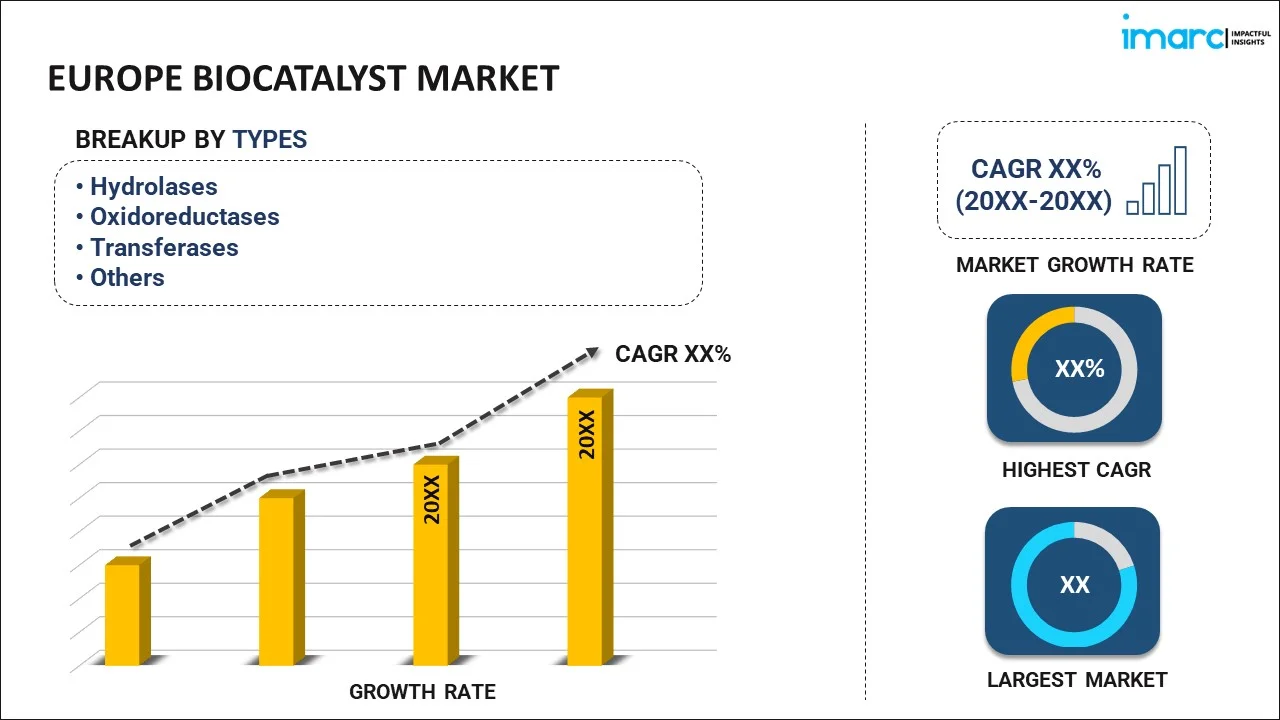
Europe Biocatalyst Market Report by Type (Hydrolases, Oxidoreductases, Transferases, and Others), Application (Food and Beverages, Cleaning Agent, Biofuel Production, Agriculture and Feed, Biopharmaceuticals, and Others), Source (Microorganisms, Plants, Animals), and Country 2025-2033
Market Overview:
The Europe biocatalyst market size reached 54.8 Kilo Tons in 2024. Looking forward, IMARC Group expects the market to reach 74.6 Kilo Tons by 2033, exhibiting a growth rate (CAGR) of 3.32% during 2025-2033.
|
Report Attribute
|
Key Statistics
|
|---|---|
|
Base Year
|
2024
|
|
Forecast Years
|
2025-2033
|
|
Historical Years
|
2019-2024
|
|
Market Size in 2024
|
54.8 Kilo Tons |
|
Market Forecast in 2033
|
74.6 Kilo Tons |
| Market Growth Rate 2025-2033 | 3.32% |
Biocatalysts refer to enzymes or microbes that accelerate or initiate chemical reactions in a living body. Generally present in plants, animals and microorganisms, they help modify the rate of chemical reactions and the conversion of organic compounds. They are biodegradable and organic in nature while being characterized by superior catalytic efficiency. Consequently, they are utilized to manufacture statins, antibodies, amino acids and vitamin supplements in the pharmaceutical industry.
The market in Europe is primarily driven by an enhanced focus on sustainable development. This has impelled multiple key players in the region to engage in partnerships and merger and acquisition (M&A) activities to create numerous growth opportunities in the market. Other factors, such as extensive research and development (R&D), along with rapid substitution of chemical catalysts with biocatalysts across industries and technological advancements in the product process, are creating a positive outlook for the market further across the region.
Key Market Segmentation:
IMARC Group provides an analysis of the key trends in each sub-segment of the Europe biocatalyst market report, along with forecasts at the regional and country level from 2025-2033. Our report has categorized the market based on type, application and source.
Breakup by Type:

- Hydrolases
- Oxidoreductases
- Transferases
- Others
Breakup by Application:
- Food and Beverages
- Cleaning Agent
- Biofuel Production
- Agriculture and Feed
- Biopharmaceuticals
- Others
Breakup by Source:
- Microorganisms
- Plants
- Animals
Breakup by Country:
- Germany
- France
- United Kingdom
- Italy
- Spain
- Others
Competitive Landscape:
The competitive landscape of the industry has also been examined along with the profiles of the key players.
Report Coverage:
| Report Features | Details |
|---|---|
| Base Year of the Analysis | 2024 |
| Historical Period | 2019-2024 |
| Forecast Period | 2025-2033 |
| Units | Kilo Tons |
| Segment Coverage | Type, Application, Source, Country |
| Countries Covered | Germany, France, United Kingdom, Italy, Spain, Others |
| Customization Scope | 10% Free Customization |
| Post-Sale Analyst Support | 10-12 Weeks |
| Delivery Format | PDF and Excel through Email (We can also provide the editable version of the report in PPT/Word format on special request) |
Key Questions Answered in This Report
The Europe biocatalyst market reached a volume of 54.8 Kilo Tons in 2024.
We expect the Europe biocatalyst market to exhibit a CAGR of 3.32% during 2025-2033.
The sudden outbreak of the COVID-19 pandemic had led to the implementation of stringent lockdown regulations across several European nations resulting in temporary closure of numerous end-use industries for biocatalysts.
The rising demand for biocatalyst in the production of biofuels and biopharmaceuticals owing to its environment sustainability is primarily driving the Europe biocatalyst market.
Based on the type, the Europe biocatalyst market can be categorized into hydrolases, oxidoreductases, transferases, and others. Currently, hydrolases account for the majority of the total market share.
Based on the application, the Europe biocatalyst market has been segregated into food and beverages, cleaning agent, biofuel production, agriculture and feed, biopharmaceuticals, and others. Among these, food and beverages currently hold the largest market share.
Based on the source, the Europe biocatalyst market can be bifurcated into microorganisms, plants, and animals. Currently, microorganisms exhibit a clear dominance in the market.
On a regional level, the market has been classified into Germany, France, United Kingdom, Italy, Spain, and others, where Germany currently dominates the Europe biocatalyst market.
Need more help?
- Speak to our experienced analysts for insights on the current market scenarios.
- Include additional segments and countries to customize the report as per your requirement.
- Gain an unparalleled competitive advantage in your domain by understanding how to utilize the report and positively impacting your operations and revenue.
- For further assistance, please connect with our analysts.
 Inquire Before Buying
Inquire Before Buying
 Speak to an Analyst
Speak to an Analyst
 Request Brochure
Request Brochure
 Request Customization
Request Customization




.webp)




.webp)












